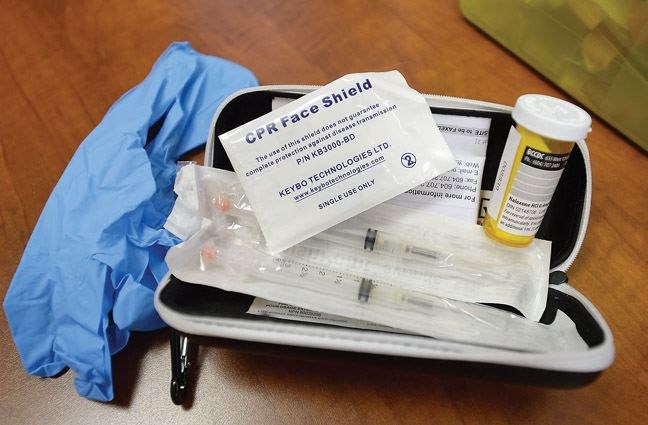Overdoses have decreased significantly since last week's spike but continue to show higher-than-normal numbers in Prince George.
Northern Health and Prince George RCMP sent out a warning Nov. 23 after the city saw 12 overdoses in three days.
That number almost doubled by the end of the week, with 22 overdoses. It dropped to three overdoses this week, but that's still higher than the one or two Northern Health would typically treat in an average week.
"Things are tapering off in terms of the number of overdoses that we're seeing but there still not back to the level they were at a few weeks ago," said Medical Health Officer Dr. Andrew Gray, adding the "normal" he's referencing is still a new reality. "Years ago we didn't see this many."
Last week, Gray said first responders had to give higher-than-normal amounts of naloxone to reverse the overdose effects, but he didn't know if that was still the case. Also last week, Vancouver police warned users about carfentanil after seizure of the opioid, which is used to tranquilize elephants and believed to be 100 times more powerful than fentanyl. This week, police found carfentanil at the home of a man who fatally overdosed.
That combined with observations from local doctors that the recent overdoses victims were reacting differently than what doctors were used to seeing with fentanyl, suggested a new substance might be in the city.
"The fact that we're seeing increase in overdoses right across the province... and the sign that we're seeing carfentanil detected, we're certainly suspicious that that might be what's going on, though we don't have concrete evidence of that," Gray said.
It's also not clear what prompted the drop in overdoses to three this week - a combination of effective public awareness and prevention tactics from users or if it's a case that a new substance is no longer on the market.
"Word tends to get out quickly. People are trying to be safe in the vast majority of cases... The vast majority of overdoses are not intentional," Gray said. "It's hard to say what drives these things. It could also just be... maybe there's just not much of (the drug) around anymore."
That means the city could see a spike again if the drug came back north.
"Unfortunately that's one of the troubles with the black market, it's unpredictable."
Either way, health officials keep reminding users of the same preventative messages.
"There are lots of strategies to use more safely, not using alone, using with someone who has had response training, and ideally naloxone, to not mix substances if possible, use smaller doses, test doses if you're not sure what you've got and certainly to call 911 immediately if an overdose does occur."
Overdoses have decreased significantly since last week's spike but continue to show higher-than-normal numbers in Prince George.
Northern Health and Prince George RCMP sent out a warning Nov. 23 after the city saw 12 overdoses in three days.
That number almost doubled by the end of the week, with 22 overdoses. It dropped to three overdoses this week, but that's still higher than the one or two Northern Health would typically treat in an average week.
"Things are tapering off in terms of the number of overdoses that we're seeing but there still not back to the level they were at a few weeks ago," said Medical Health Officer Dr. Andrew Gray, adding the "normal" he's referencing is still a new reality. "Years ago we didn't see this many."
Last week, Gray said first responders had to give higher-than-normal amounts of naloxone to reverse the overdose effects, but he didn't know if that was still the case. Also last week, Vancouver police warned users about carfentanil after seizure of the opioid, which is used to tranquilize elephants and believed to be 100 times more powerful than fentanyl. This week, police found carfentanil at the home of a man who fatally overdosed.
That combined with observations from local doctors that the recent overdoses victims were reacting differently than what doctors were used to seeing with fentanyl, suggested a new substance might be in the city.
"The fact that we're seeing increase in overdoses right across the province... and the sign that we're seeing carfentanil detected, we're certainly suspicious that that might be what's going on, though we don't have concrete evidence of that," Gray said.
It's also not clear what prompted the drop in overdoses to three this week - a combination of effective public awareness and prevention tactics from users or if it's a case that a new substance is no longer on the market.
"Word tends to get out quickly. People are trying to be safe in the vast majority of cases... The vast majority of overdoses are not intentional," Gray said. "It's hard to say what drives these things. It could also just be... maybe there's just not much of (the drug) around anymore."
That means the city could see a spike again if the drug came back north.
"Unfortunately that's one of the troubles with the black market, it's unpredictable."
Either way, health officials keep reminding users of the same preventative messages.
"There are lots of strategies to use more safely, not using alone, using with someone who has had response training, and ideally naloxone, to not mix substances if possible, use smaller doses, test doses if you're not sure what you've got and certainly to call 911 immediately if an overdose does occur."



